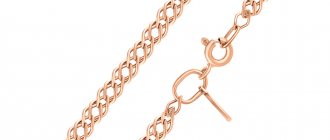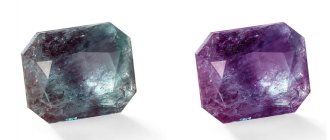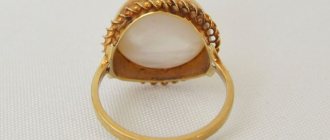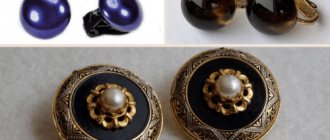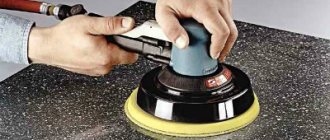- Clasp requirements
- Crochet lock - beauty in simplicity
- Spring lock - simple and reliable
- Carabiner – strong and durable
- Screw lock – ideal for necklaces and chokers
- Box lock – for heavy jewelry
- Hinge locks - originality and aesthetics
- Buckle lock - convenient, but unreliable
- Toggle castle - an element of antique style
- Barrel clip clasp
When looking for a new accessory, people most often pay attention to its appearance, beauty and attractiveness. But there is another important aspect of selection, and that is reliability. Agree, it’s not very pleasant if a recently purchased piece of jewelry begins to fall off, twist, or come undone at the most inopportune moment. Therefore, when purchasing, you need to pay special attention to the locking mechanism of the product. From this article you will learn what types of locks for chains and bracelets are, how they function and which models should be preferred.
Clasp requirements
It is the lock that bears the greatest load during operation. And by attaching additional pendants to the bracelet or putting a pendant on the chain, you almost double it. Because of this, the fragile mechanism can weaken, become deformed, or even burst. Therefore, when purchasing an accessory, make sure that the clasp meets the following requirements:
- the lock must be as tight as possible, while its parts must move smoothly, without hesitations or jerks;
- the accessory looks more presentable when the appearance of the mechanism is harmoniously combined with the design of the product itself;
- the fastener should not have sharp corners, nicks or unpolished edges that could scratch the skin;
- latches that open with one hand are more convenient and practical to use.
All bracelet locks must meet these standards. But now jewelers have developed many varieties of clasps, differing in configuration, size, and quality. Read about their advantages and disadvantages below.
What types of locks are there on chains made of gold or silver?
Locks on chains made of precious metals should be as reliable as possible. Otherwise, they may unexpectedly open up one day, and the jewelry will unnoticeably slip off the neck and get lost. This is especially unpleasant when the chain is an exclusive product, a gift from a dear person, or is complemented by an amulet pendant or a pendant with a large expensive stone. There are different types of locks on gold chains. When choosing, you need to pay attention to their functionality and harmony with the decoration style. The lock must securely fix the product on the neck and not cause any discomfort to its owner. What types of chain clasps are there? Let's look at the most common types.
Spring lock - simple and reliable
The spring ring clasp mechanism is a hollow ring in which a spring fastener is located.
Locks of this design are mass-produced in large factories, which is why they can be seen on most costume jewelry. Such a fastener weighs little, is small and at the same time quite durable. Therefore, it is often placed on silver chains, as well as on narrow, light bracelets. But the model also has disadvantages - the spring that secures the lock can weaken or burst, unable to withstand the load, which will lead to the loss of the accessory. In addition, the miniature bolt can be difficult to hold in your fingers, especially when you are wearing a bracelet.
How to open a Pandora bracelet?
This question is especially relevant if there is no key. The following items are most convenient to use:
- a plastic card is the most correct and most common solution;
- nail files;
- record mediator;
- regular paper clip;
- thin coin
The P-LOCK lock is quite strong and can ruin your manicure. You should not open it with metal objects: there is a risk of leaving a scratch or breaking the mechanism. It is better to use plastic, the safest and most effective material. The clips can also be opened using a plastic card.
Carabiner – strong and durable
This type of lock is also known as “Hook buckle clasp” and “Lobster claw”.
The mechanism looks like a hinge, one side of which is replaced by a moving bracket. To open it, you need to press the spring-loaded latch, so the connecting ring attached to the carabiner can almost never fall out. Compared to spring locks, such locks can withstand more weight, and they are also more convenient to use. Carbines are assembled by hand, so another advantage is the ability to repair damaged products and replace worn springs. Therefore, if you are planning to buy a silver bracelet, give preference to models with a similar clasp.
The only caveat is that sometimes you need to inspect the structure. Sharp jerks deform the lock hinge, creating a gap between this part and the movable bracket into which the connecting ring can slip.
Features of removing a bracelet with a heart
A new type of lock is represented by the Pave heart model. It is used for Bangle version bracelets - rigid, inflexible .
The proprietary mechanism here is also a cylindrical p-lock and opens in the same way as in the flexible versions with a “barrel”. The lock in the model is made in the shape of a heart, covered with Swarovski crystals. You need to open it with a branded key or replace it with some durable thin object. It is more difficult to cope with this task without a master key, because the shape of the heart is geometrically irregular, and it is not always possible to move the edges of the lock to the sides the first time . When working without a key, be very careful to avoid scratching the metal surface and risking the rhinestones flying off. In order to remove an accessory of this type, you need to open the latch and, stretching, pull it through your hand.
How to choose a brooch for clothes?
Style of women's trousers
Screw lock – ideal for necklaces and chokers
These fasteners are made of two oblong threaded parts that screw onto each other. They look very aesthetically pleasing, complementing bead jewelry well, as well as silver chains decorated with pendants and pendants. Using screw locks is very simple, so products equipped with them are suitable for almost everyone. It is only necessary to check the reliability of the connection of the elements from time to time, tightening them if necessary.
Box lock – for heavy jewelry
Box clasps, or “Box clasps,” look like two pieces of a puzzle—a latch—a strip folded in half, with several protrusions at the tip—is inserted into a square or rectangular hollow piece with a hole.
Placed in a box, it is held inside by these notches, and when the jewelry needs to be unfastened, the bar is simply compressed so that it becomes flatter and easily slides into the gap. Sometimes the mechanism is equipped with additional fixing loops (they make the structure more reliable, but can cling to clothing) or its shape is changed. This type of fastener is less common than carbines and spring locks, primarily due to the complexity of their manufacture. But they fit perfectly into the overall design of the accessory, without disturbing the overall harmony of the lines. Therefore, only the most exquisite and expensive silver jewelry is equipped with such models. And also because the box lock can easily withstand significant loads, they are placed on massive necklaces and wide bracelets with large links.
How to wear a Bangle bracelet
Bangle translates to "hard". This bracelet shape comes from India. Otherwise, it is also called an open Pandora bracelet. It is put on by stretching, there are no additional locks. The cap can be twisted, but this is done only to put on or remove the “charm”. To do this, you just need to unscrew the plug in the shape of a heart or a ball, it depends on the model.
It is important to remember that you should not try to remove or put on the bracelet through your hand; this can only be done through your wrist. Because they tend to stretch over time. When removing an open Pandora bracelet through a hand, it is easy to deform.
Hinge locks - originality and aesthetics
These mounts are based on a movable connection between two elements, which allows them to rotate freely around their axis.
A pin is inserted into the loops of the fastener - a kind of “nail” made of durable metal, which secures the entire device. Hinge locks look best on solid (rigid) bracelets. Sometimes they are also supplied with glider decorations consisting of individual links.
Buckle lock - convenient, but unreliable
This mechanism also works on hinges, but without a pin.
It is replaced by a latch, which folds in half and is then fixed using a special strip with holes. These locks can be seen on metal watch bracelets, as well as on casual jewelry that combines metal, leather and rubber. Fastening the buckle is very easy. But, unfortunately, it also opens almost effortlessly. This means that you may well lose your jewelry simply by touching an object with your wrist or by accidentally pulling on the bracelet.
The most reliable types of chain locks
Despite the fact that there are many types of locks, not all of them can be called reliable. Some of them open up on their own during wear, and you are very likely to lose the item.
Interesting! Most modern expensive chains are made with a fancy locking device. I don’t even want to hide such mechanisms. Small details can perfectly complement your look.
The most reliable locks:
- Carabiner. A simple lock that can last a long time
- Crutch. A light and elegant lock, but at the same time it prevents the chain from unfastening and falling.
- Box. Often used in expensive and massive jewelry. This allows the owner of the chain not to worry about its reliability.
- Chain lock. Similar to “boxes”, but designed for thin chains.
- Butterfly. More often found in massive jewelry or watches.
Toggle castle - an element of antique style
Crutch locks (from the English “Toggler clasp”) are very simple, but despite this, they are convenient and reliable.
They are a large ring into which a T-shaped pin is inserted. Its “shoulders” are slightly wider than the diameter of the round link, so they can only slide into it at an angle. And due to the tension force, an accessory with such a lock is securely fixed and does not come unfastened - of course, if you are not wearing an overly wide decoration. Similar fasteners are found on archaeological monuments of the ancient era. And modern jewelers and designers often use them when making works in ethnic style.
Locks for bracelets
Nowadays it is easy to buy a clasp for a bracelet of almost any shape, color and design. The problem is usually which one to choose. When you first start doing needlework, it is not always clear which fastener is best suited, which one will be more reliable and which one will be more convenient to use.
We'll tell you all the details, explain what to look for when choosing, and tell you when a bracelet can do without a clasp at all (yes, this happens).
What types of clasps are there for bracelets?
Clasps for jewelry come in a variety of varieties.
But only some of them are suitable for bracelets. The rest are either inconvenient to use (for example, screw clasps used to fasten necklaces and beads). Or they are needed for a specific base, from which bracelets are not made (for example, connectors for ball chains). Here's a complete list of what's eligible.
- Carbines
- Toggles
- Hooks
- Magnetic clasps
- Latch locks
Now about each in more detail.
Carbines
. The most common clasps for jewelry in general and for bracelets as well. You've probably seen them many times. They come in different colors, sizes and even slightly different shapes. A “lobster” is commonly referred to as a teardrop clasp. A slightly longer version of the same lock is called a “lobster” lock. Probably because it looks like the claw of this same lobster. The word is different, but the principle of operation is the same: part of the claw is movable, bends inward if you press, and then snaps into place.
To open such a lock, you need to pull on a small special protrusion. And this method of opening is the main problem and disadvantage of carabiners. Most of them are difficult, some are even impossible to unfasten with one hand. Small carabiners are especially difficult to open; the release tab can be so tiny that you have to use both hands. To remove a bracelet with such a lock, you need to call someone for help. Of course, calling someone is not the biggest problem in life (and even an extra reason to show off your jewelry), but taking off a bracelet every time with outside help is somehow not very fun.
But carbines also have a very important advantage. They allow you to make a clasp of adjustable length. This is necessary, for example, in bracelets made for sale, when the exact size of the future owner’s wrist is not known.
To adjust the length, the carabiner is supplemented with a small (about 5 cm) chain. There are already ready-made sets - carabiner, chain, clips - but buying everything separately and assembling it yourself is also not difficult. It works simply: the carabiner clings to different links of the chain, making the bracelet wider or narrower.
| Surgical steel carabiners | Gold carabiners | Carabiners for adjustable length bracelets |
Advantages
.
You can make fasteners adjustable in length. Flaws
. Small carabiners are difficult to unfasten with one hand.
Toggles
. Unlike carabiners, such fasteners can come in a variety of shapes. Hearts, flowers, leaves - whatever. Nothing prevents you from using toggles not only as a clasp, but also as a bracelet decoration 
With all the external diversity, toggles cannot be confused with other locks. Regardless of the shape, they always consist of two parts: a stick and a ring into which it is threaded.
Many craftsmen consider this clasp not very reliable. It seems that the wand can slip out of the ring with the slightest shake. In reality, of course, everything is not like that. Look, the toggle lock is as easy to use as a regular button. The button slips into the eyelet, stays in it and does not slip back out because it is larger in size than the eyelet. In a toggle, the wand is also larger than the ring. And she stays in it just as securely.
Toggles have been known since ancient Greece. It is unlikely that they would still be used if they really were so unreliable. In addition, they do not contain any unnecessary details. No springs or latches that can fall apart or jam. And an added bonus for the bracelets: the toggles can be easily opened and fastened with one hand.
Durable metal toggles are well suited for chunky bracelets with large beads or natural stone pendants. However, sometimes large beads near the clasp itself make it difficult to fasten the toggle. You can’t guess here in advance; you can only check it in practice. If they really get in the way, you can choose smaller beads closer to the lock or even leave the cord in this place without additional decorations.
| Toggles for bracelet | Leaf clasp | Heart shaped toggle |
Advantages
.
You can choose a clasp of an unusual shape and even use it as a separate decoration. Suitable for large bracelets with heavy pendants and massive beads. Easily unfastens with one hand. Suitable for decorations in ethno style. Flaws
. The toggle clasp is not adjustable in length.
Hooks
. Such clasps are placed on leather bracelets or on bracelets with massive decorations. They may look different.
- Two S-shaped hooks that cling to each other.
- Hook and loop.
- A separate hook or anchor attached to a loop of cord.
Some hooks look so impressive that they are used as the main (and even the only) decoration of a bracelet.
Remember, for example, men's bracelets with an anchor. A strong leather cord plus a metal anchor clasp - and nothing else is needed for this harsh and beautiful romance. The hooks are quite easy to unfasten with one hand. But they are completely unsuitable for small and light bracelets. There they look too massive and are fastened unreliably: just shake your hand poorly and the bracelet will open and fall.
Length-adjustable fasteners are made from hooks and anchors, which are fastened with a loop of cord (leather or suede). By tightening or loosening the loop, you can decrease or increase the size of the entire bracelet.
| Anchor Bracelet Clasp | Lock for a bracelet in ethnic style | S-hooks |
Advantages
.
Suitable for bracelets with heavy jewelry. Can be used as an additional (and even the only decoration). Can be used with an adjustable clasp. Look good on ethnic style bracelets. Flaws
. Not suitable for small bracelets.
Magnetic clasps
. Consist of two magnetized halves. Often such locks are equipped with an additional mechanical lock - for reliability. To unfasten it, you need to slightly turn or lift the halves of the lock one above the other.
The bracelet's magnetic clasp opens easily with one hand. In shape it usually resembles a ball or an elongated stick cut along the length. Depending on the shape, such fasteners are produced for single-row (one turn of cord) or multi-row (two-three-five turns) bracelets.
| Lock with connecting rings | Fastener with end caps for gluing cord | Clasp for multi-row bracelet |
Advantages
.
Easier to open with one hand than any other fastener. You can immediately select a clasp for both a single-row and a multi-row bracelet. Flaws
. The clasp is not adjustable in length. It is better not to use for bracelets with heavy pendants and massive beads.
Latch locks
. Buttons and buckles, which are fastened by an internal spring. They are easy to fasten and unfasten with one hand. Bracelets with such clasps can only be made to a certain length; they cannot be adjusted to suit different wrist widths.
Another disadvantage: this type of clasp can open unexpectedly. If you accidentally catch the bracelet on something, the button will unfasten due to tension and the bracelet will fall off your hand.
Like magnetic clasps, latches are available for single-row and multi-row bracelets.
| Snap closure | Lock for multi-row bracelet | Snap clasp for 1 or 3 row bracelet |
Advantages
.
Easily fastens and unfastens with one hand. Withstands the weight of heavy beads and pendants. Flaws
.
Not adjustable in length. May come undone by accident. Return to catalog
Which lock to choose
All bracelet clasps should be easy to unfasten with one hand.
Therefore, before you buy, it is better to try how easily the carabiner opens in your fingers. Then everything depends on the design of the product.
- For small lightweight bracelets - latches, carabiners and magnetic clasps that match the color and style.
- For bracelets made of leather cord and suede cord - hooks and toggle clasps.
- For massive bracelets with large beads and pendants - hooks, toggles and large carabiners.
- For bracelets that need to be adjusted in width, use carabiners. And hooks, if it is fastened with a loop of cord.
Return to catalog
How to attach a clasp to a DIY bracelet
The most common method of fastening is connecting rings.
With these rings, carabiners and toggles are attached to any base for a bracelet: jewelry cable, chain and pins. It happens that fasteners are produced immediately with ends that need to be glued, crimped or sewn to the edges of the cord.
Some hook fasteners do not require rings or ends. They are simply tied to the cord from which the bracelet is made.
Return to catalog
When can you do without a clasp?
In general, the lock is needed only so that the bracelet can be unfastened and put on first.
And then fasten it so that it does not fall off your hand. But there are bracelets that can be worn without unfastening. They are assembled on an elastic basis, you can stretch them a little, insert your palm, and on the wrist such a bracelet again takes its previous shape. Therefore, bracelets with an elastic band do not need a clasp. Of course, the elastic cannot stretch indefinitely and the size of such a bracelet still needs to be selected in advance. But there is definitely no need to put a lock on it.
A multi-row bracelet made with memory wire works just as well without a clasp. When it is put on, the wire stretches (by the way, it also needs to be selected according to the size: there are coils narrower and wider). On the memory wrist, the wire is twisted to its previous diameter, the bracelet does not slip off the hand and does not dangle.
On some types of bracelets, it is customary to make the clasp yourself. For example, bracelets woven from waxed cords are equipped with a braided clasp adjustable in length. The same can be done on a leather cord.
Return to catalog
Main thoughts briefly
- The clasp for the bracelet should be easy to unfasten with one hand.
- Toggles and hook clasps are also used as additional decoration.
- The lock is attached to the bracelet with connecting rings or end caps, which are sold complete with it.
- It is better to fasten heavy bracelets with large carabiners, toggles or metal hook clasps.
- If you want to make a bracelet with an adjustable clasp, take a carabiner and an extension chain.
Barrel clip clasp
The most convenient type of lock is considered to be a barrel clasp. You can fasten it yourself with one hand. This type of lock is used by the Pandora brand, giving the bracelet some originality. In addition to being easy to use, it is reliable, protecting the product from loss.
Now you know how to choose and buy a silver chain or bracelet that will not only be attractive, but also durable. And our online store “Amber Polesie” is always happy to provide you with original and high-quality models, decorated with magnificent gems!
Butterfly
One of the most reliable locks. On chains, the butterfly is less common than other types of fasteners. The fittings prevent arbitrary unfastening and prevent accidental loss of jewelry. The clasp has a butterfly shape and is quite large in size, but is almost invisible on the products.
On the left is a figure eight lock, on the right is a butterfly lock.
